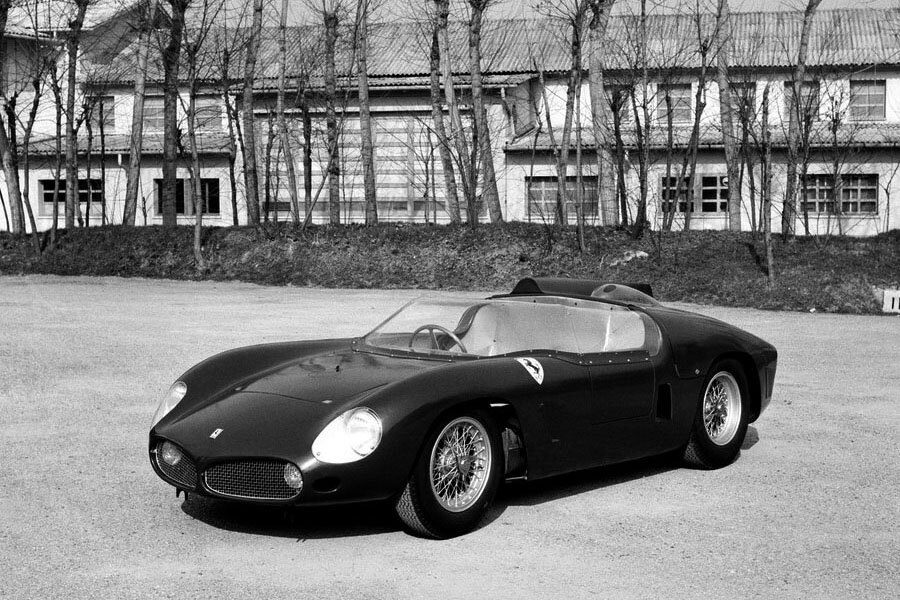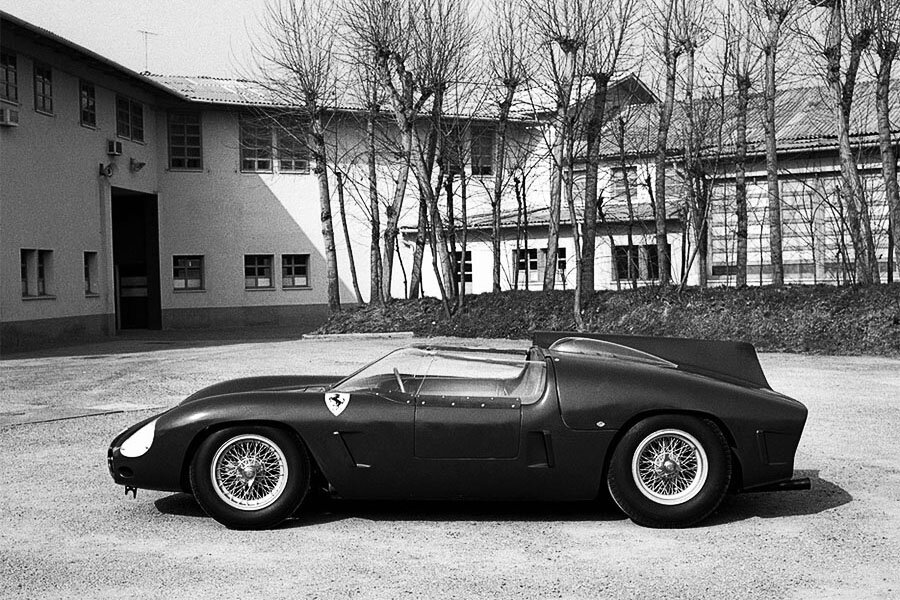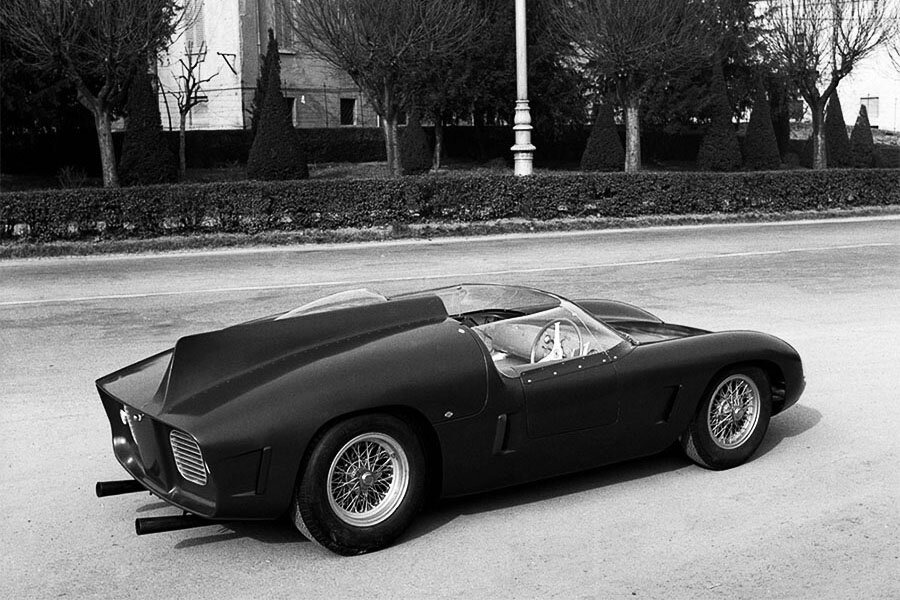Guide: Ferrari SP/61 - a Historical & Technical Appraisal
/BACKGROUND
Enzo Ferrari was notoriously conservative when it came to certain kinds of technical developments. He famously stated that “aerodynamics are for people who can’t build engines” and, in relation to mid-engined racing cars, “the horse should pull the cart and not push it”.
However, by the early 1960s, it was clear aerodynamics were vitally important as speeds edged continually upwards. Likewise, English “garagistes” had proven the mid-engined layout was the way forward; the last time a front-engined car won an F1 championship was 1958.
With the writing on the wall, Ferrari trialled an experimental mid-engined F1 car at two races in 1960.
For 1961, the team switched full time to a mid-engined Formula 1 car and used a combination of front and mid-engined layouts for the World Sportscar Championship.
The three new Scuderia Ferrari racing cars were unveiled at the Maranello Press Conference in February 1961. They comprised the V6-engined 246 SP (SP/61) which was displayed alongside the latest front V12-engined challenger (the 250 TRI/61) and the 156 Formula 1 car.
Having lost the 1959 World Sportscar Championship to Aston Martin, Ferrari had regained their title in 1960 after beating Porsche on a tie-break. Aside from defeat to Aston Martin in 1959 and Mercedes-Benz in 1955, Ferrari had won the championship every year since its 1953 inception.
The 1961 series would be contested over five rounds: the Sebring 12 Hours, the Targa Florio, the Nurburgring 1000km, the Le Mans 24 Hours and the Pescara 4 Hours.
Although the threat from Aston Martin had disappeared (they had quit at the end of 1959), Maserati's satellite teams were gearing up for a serious attack with their latest Tipo 61 and Tipo 63 ‘Birdcage’ models.
Likewise, the threat from Porsche’s factory squad could not be discounted even though at this stage the Germans generally contested the under two-litre class.
CHASSIS
The SP/61 was built on a brand new Tipo 561 tubular steel chassis with a 2320mm wheelbase.
Suspension was via unequal length wishbones, coil springs, telescopic shocks and a front anti-roll bar.
Each sill housed a 57.5-litre fuel tank. Quick filler caps were added to the front fenders soon after launch.
The water radiator and oil cooler were mounted in the nose.
Disc brakes were fitted all round (inboard at the rear).
15-inch diameter Borrani wire wheels measured 5.5-inches wide at the front and 6.5-inches wide at the rear.
ENGINE / TRANSMISSION
The SP/61 was powered by an evolution of the Vittorio Jano-designed Dino V6 that had been used in a variety of applications since 1957.
The idea for a dual overhead camshaft 65° V6 had originally been proposed by Enzo Ferrari’s son, Alfredo. However, Alfredo died from muscular dystrophy in 1956 before the new engine came to fruition.
Alfredo was more commonly known by his nickname, Dino, which his father chose to grace certain V6-powered Ferraris thereafter.
The all-alloy Dino V6 was mounted mid longitudinally in the chassis. It displaced 2417cc thanks to a bore and stroke of 85mm and 71mm respectively.
Dry-sump lubrication was employed along with two valves per cylinder, single plug ignition and two coils.
With a compression ratio of 9.8:1 and three Weber 42 DCN downdraught carburettors, peak output was 270bhp at 8000rpm.
Power was transmitted to the road through a five-speed manual gearbox, twin plate clutch and limited-slip differential.
BODYWORK
Prior to its introduction, scale models of the SP/61 had been refined in a small wind tunnel built at the request of Ferrari’s chief designer, Carlo Chiti.
Like the 156 F1 car and 250 TRI/61, the SP/61 adopted Chiti's trademark ‘Sharknose’ front end that looked great even if it wasn’t of much real world benefit.
A wraparound windscreen conformed to minimum height requirements set by the FIA. The sides of the windscreen swept around to a higher than usual rear bulkhead.
The rear deck sloped down to a Kamm tail and housed a vertical tail fin devised to increase stability. The rear body section could be quickly detached for easy access to the engine bay during races.
Body panels were fabricated in the thinnest available aluminium at the Fantuzzi works in Modena.
INTERIOR
Aside from the seats (trimmed in bright blue fabric), there was no upholstery to speak of. Instead. most of the surfaces were left in bare unpainted aluminium.
Directly behind the three spoke wood-rimmed steering wheel was a large tachomoter. Smaller gauges for fuel, oil and water were mounted either side.
Both SP/61s constructed were built in right-hand drive with a right-hand open gate gear lever.
WEIGHT / PERFORMANCE
Ferrari quoted a dry weight of 590kg and a 168mph top speed. With the highest possible gear ratio, 0-62mph required comfortably less than five seconds.
TESTING
Testing began at the Modena Autodrome immediately after the Maranello Press Conference in February 1961. However, it soon became apparent that the windscreen and tail fin made the car very unstable.
Not long after the programme had got underway, a brake failure caused Wolfgang von Trips to roll the solitary SP/61 thus far created (chassis 0790). Thankfully, von Trips emerged unscathed and damage was limited. The car was quickly rebuilt but this time without the tail fin.
Testing resumed and, when Richie Ginther suggested adding a rear spoiler, the ill-handling SP/61 was transformed.
1961 SEBRING 12 HOURS
Scuderia Ferrari confidently sent three cars out to Florida for the opening round of the 1961 World Sportscar Championship: the Sebring 12 Hours on March 25th.
The solitary SP/61 (0790) was entered for Richie Ginther / Wolfgang von Trips. By this time it had been further refined with a variety of extra cooling ducts and vents.
Also present were a brace of of 250 TRI/61s for Phil Hill / Olivier Gendebien and Giancarlo Baghetti / Willy Mairesse.
A big Ferrari-Maserati battle was expected; the works-supported Camoradi International and Momo Corporation teams were on hand with their Tipo 63s and Tipo 61s. A smattering of Ferraris from NART would also be in contention.
Grid positions were decided on engine size which meant Ginther started 27th in the SP/61.
The flag fell at 10am and Masten Gregory took the lead in his mid-engined Camoradi Maserati Tipo 63. He was closely followed Pedro Rodriguez (NART 250 TR 60), Walt Hansgen (Momo Tipo 63), Phil Hill in the works TRI and Ginther in the SP/61.
After 15 laps, the Ferraris had taken control. Rodriguez headed the field with Hill second and Ginther third in the SP/61. The Maseratis of Hansgen, Gregory and Stirling Moss (who had started slowly because of a flat battery) were fourth, fifth and sixth.
Ginther moved the SP/61 into the lead at around the one hour mark. Hill was still second in the works TRI but Moss was closing rapidly in his front-engined Camoradi Tipo 61.
Shortly after the three hour mark, Moss went out with suspension damage.
Wolfgang von Trips soon followed. The German had taken over from Ginther in the SP/61 and was leading the race when he came into the pits. One too many kerbs had been clouted and von Trips was forced to abandon with broken steering.
The remainder of the race saw the Maseratis drop out one by one.
First and second spots ultimately went to the works 250 TRI/61s of Hill / Gendebien and Baghetti / Mairesse. Pedro and Ricardo Rodriguez took third in the NART 250 TR 60.
1961 LE MANS TEST
Scuderia Ferrari’s next appearance with the SP/61 was at the Le Mans Test which took place over the weekend of April 8th and 9th.
Hill, Ginther, von Trips and Mairesse were present along with a solitary SP/61 (0790) and a 250 TRI/61.
Soon after practice began, Mairesse bent the front engined car which suffered front and rear body damage. Fortunately, the team managed to effect repairs by late in the day.
Ginther initially went fastest, setting a new lap record in the SP/61 which was later eclipsed by Hill in the same car.
The mid-engined Ferrari ended the weekend fastest followed by the repaired 250 TRI/61. Third through fifth positions were occupied by mid-engined Tipo 63 Maseratis from Scuderia Serenissima and Briggs Cunningham.
1961 TARGA FLORIO
Sicily hosted round two of the 1961 World Sportscar Championship on April 30th: the Targa Florio.
Scuderia Ferrari took three cars for the gruelling event: a brace of SP/61s for Phil Hill / Olivier Gendebien and Wolfgang von Trips / Richie Ginther plus an older front-engined 250 TRI/60 for Ricardo Rodriguez / Willy Mairesse.
As the team had not taken any practice hacks, the drivers were forced to do all their reconnaissance laps in Fiat 600 hire cars.
The Hill / Gendebien SP/61 was a brand new car (chassis 0796) which the team had forgotten to fit with a conical baffle in the fuel tank. This meant that, during the first try out, the car kept spinning on fuel that was slopping out from the tanks.
For the race, Gendebien was set to drive the opening stint in the new car. However, before the start, the Ferrari team agreed that, if anything happened to the Hill / Gendebien machine, they would take over the von Trips / Ginther example (0790).
Realising that if he started the race and broke down on track, Hill would get to take over the second car instead of him, Gendebien became temperamental and forced Hill to start.
A ruffled Hill drove off in a thoroughly bad temper. He stormed past a host of slower machines and struck several as he went (including von Trips). His car already had a crumpled nose when he came out of a corner too quickly and went off the road, into a ditch and instant retirement.
Gendebien therefore joined von Trips and bumped Ginther out of the second SP/61.
Wolfgang von Trips drove the opening session in 0790 and was soon into his stride. On lap two, he was third behind the nimble Porsche 718 RS of Stirling Moss and Jo Bonnier.
At the end of lap four, von Trips handed over to Gendebien and Moss pitted for Graham Hill to take over the lead Porsche.
Gendebien was quickly into second place and soon just a few seconds behind Graham Hill. The two cars exchanged the lead several times during the ten lap race.
With Moss re-instated, the Porsche seemed to have the race in the bag until it coasted to a stop with a stripped crown-wheel and pinion.
Victory at the Targa Florio thus went to von Trips / Gendebien with Porsches second and third. The Scuderia Serenissima Maserati Tipo 63s placed fourth and fifth.
1961 NURBURGRING 1000KM
Four weeks later, Scuderia Ferrari took a three-car team to the Eifel mountains of Germany for the Nurburgring 1000km (May 28th).
For this event, the brace of SP/61s that appeared in Sicily were joined by a works 250 GT SWB Berlinetta for Willy Mairesse and Giancarlo Baghetti.
Phil Hill and Wolfgang von Trips were paired in chassis 0796 (the SP/61 crashed by Hill on the Targa Florio). Richie Ginther and Olivier Gendebien drove 0790 (the Targa Florio winner).
In response to complaints from drivers about poor visibility through the tall windshields mandated for 1961, the FIA announced a 35cm slot could be cut away. Ferrari modified 0790 and 0796 accordingly.
The Ginther / Gendebien entry went quickest in practice to secure pole. Next up was the two-litre Porsche 718 RS of Stirling Moss / Graham Hill followed by Phil Hill / Wolfgang von Trips in the second SP/61.
The 44 lap race began at 9am.
Jim Clark’s Essex Racing Team Aston Martin DBR1 was first away followed by Moss, Ginther, Hans Herrmann (718 RS), Ricardo Rodriguez (in NART’s newly uprated 61-spec. 250 TRI) and Mairesse in the works 250 GT SWB Berlinetta.
By the end of the opening 14-mile lap, Moss had moved up to first and Phil Hill had stormed through to second ahead of Ginther.
On lap two, the SP/61s moved to the head of the field which relegated Moss to third. Hill set a new lap record and then did so again on laps three, five, six, seven and eight. The SP/61s were clearly the fastest cars in the race.
On lap eight, Hill and Ginther called into the pits for von Trips and Gendebien to take over.
With 15 laps gone, von Trips had a three-and-a-half minute lead over Gendebien in the sister car.
Then on lap 16 it began to rain and freezing mist rolled in. The Stirling Moss / Graham Hill Porsche 718 RS started to close and, on lap 20, it moved into second place ahead of Ginther / Gendebien.
At the next round of stops, the Ferrari pit crew taped up various ducts to limit water ingress but the Ginther / Gendebien car was already suffering. With their carburettors icing up, they dropped down to seventh position.
At the head of the field, Moss retired the second place Porsche with engine failure on lap 21.
On lap 25, Phil Hill crashed the leading SP/61 at Flugplatz and the car briefly caught fire. 0796 was retired on the spot and would not be seen again until 1962.
Conditions later improved and von Trips joined Ginther and Gendebien in 0790.
They recovered to finish third overall.
Victory went to the Camoradi Maserati Tipo 61 of Masten Gregory / Lloyd Casner. The Maserati finished a lap ahead of runners up, Ricardo and Pedro Rodriguez, in the NART 250 TRI.
1961 LE MANS 24 HOURS
Losing one of the SP/61s ahead of Le Mans was not ideal preparation. Nevertheless, Scuderia Ferrari arrived at la Sarthe with a team of four cars: the SP/61 (chassis 0790) for Richie Ginther / Wolfgang von Trips, a pair of 250 TRI/61s for Olivier Gendebien / Phil Hill and Mike Parkes / Willy Mairesse plus a special 250 GT SWB Berlinetta with experimental bodywork for Fernand Tavano / Giancarlo Baghetti.
Although grid slots were decided on engine size, Richie Ginther posted the fastest time in official practice. The SP/61 was 3.5 seconds quicker than Hill in the 250 TRI/61 and nine faster than the Maserati Tipo 63s.
The race began at 4pm on June 10th.
Jim Clark was first away in his Border Reivers Aston Martin DBR1, but Ginther moved the SP/61 into the lead down the Mulsanne Straight and Gendebien was soon up to second in the 250 TRI/61.
Over the next six hours, these two cars and the NART 250 TRI driven by Ricardo and Pedro Rodriguez exchanged the lead several times.
At around 10:30pm, Ginther came in from the lead to have his lights fixed. The stop cost ten minutes and dropped the SP/61 to fourth.
By midnight, it had recovered to third.
As dawn approached, some hard driving from Ginther and von Trips meant they were back up to second place.
Unfortunately, at around 8am, the SP/61 failed to appear; a miscalculation meant von Trips ran out of fuel and was stranded by the side of the track.
Ferrari's blushes were saved as the works 250 TRI/61s finished first and second; Gendebien / Hill took the win from Parkes / Mairesse. Third sport went to the GT class winning 250 GT SWB Berlinetta of Pierre Noblet and Jean Guichet.
1961 PESCARA 4 HOURS
Victory at Le Mans had given Ferrari an unassailable lead in the championship standings.
As a result, just one official entry was dispatched to the season finale on August 15th: the Pescara 4 Hours.
However, in addition to the SP/61 (which was on hand for Richie Ginther / Giancarlo Baghetti), Enzo Ferrari also sent a 250 TRI/61 (plus several mechanics) for Scuderia Centro Sud.
Held on a 15 mile road circuit with a roughly triangular layout, the Pescara track comprised two main straights and a twisting mountain section.
Ginther went fastest in practice to set a new lap record in the SP/61. Co-driver Baghetti clouted some straw bales after which repairs were needed.
Cars lined up on the grid according to engine size.
The 23 lap race was underway shortly after 9am on Tuesday morning (a national Italian holiday).
Casner’s Camoradi Maserati Tipo 61 led away from the start with Ginther (SP/61) and Mairesse (driving Pierre Dumay’s 250 GT SWB Berlinetta) in hot pursuit.
By the end of lap one, Ginther had assumed the lead from Casner and Mairesse.
At the end of lap three, Ginther was in the pits complaining something seemed wrong with the SP/61’s rear suspension. This allowed Casner to re-take lead while Nino Vaccarella moved his Scuderia Serenissima Maserati Tipo 63 into third.
With an hour of racing gone, Ginther was back in the lead. A lap later (lap eight), Vaccarella, who had followed Ginther past Casner, retired with gearbox trouble.
At the end of lap nine, Ginther pitted for Baghetti to take over but halfway round lap ten, the SP/61 suffered a front suspension failure. Baghetti struggled back round to the pits with a flailing wheel where 0790 was retired.
Casner crashed out on lap 14 which meant the works-supported Centro Sud 250 TRI/61 of Lorenzo Bandini and Giorgio Scarlatti romped home to victory. It finished a lap clear of the works Porsche 718 RS of Edgar Barth / Karl Orthuber. Mennato Boffa finished third in his privateer Maserati Tipo 60.
Ferrari ended the season on 24 points compared to Maserati’s 14 and 11 for Porsche.
SUBSEQUENT HISTORIES
Both SP/61s were rebuilt to the low-body SP/62 specification during the close season.
Text copyright: Supercar Nostalgia
Photo copyright: Ferrari - https://www.ferrari.com




































